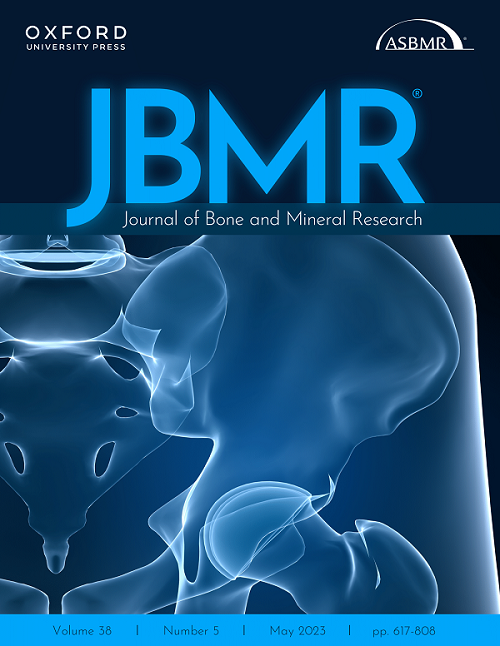Robyn S. Allen, William D. Jones, Maya Hale, Bailey N. Warder, Eileen M. Shore, Mary C. Mullins
求助PDF
{"title":"Reduced GS Domain Serine/Threonine Requirements of Fibrodysplasia Ossificans Progressiva Mutant Type I BMP Receptor ACVR1 in the Zebrafish","authors":"Robyn S. Allen, William D. Jones, Maya Hale, Bailey N. Warder, Eileen M. Shore, Mary C. Mullins","doi":"10.1002/jbmr.4869","DOIUrl":null,"url":null,"abstract":"<div>\n \n <p>Fibrodysplasia ossificans progressiva (FOP) is a rare human genetic condition characterized by altered skeletal development and extraskeletal bone formation. All cases of FOP are caused by mutations in the type I bone morphogenetic protein (BMP) receptor gene <i>ACVR1</i> that result in overactivation of the BMP signaling pathway. Activation of the wild-type ACVR1 kinase requires assembly of a tetrameric type I and II BMP receptor complex followed by phosphorylation of the ACVR1 GS domain by type II BMP receptors. Previous studies showed that the FOP-mutant ACVR1-R206H required type II BMP receptors and presumptive glycine/serine-rich (GS) domain phosphorylation for overactive signaling. Structural modeling of the ACVR1-R206H mutant kinase domain supports the idea that FOP mutations alter the conformation of the GS domain, but it is unclear how this leads to overactive signaling. Here we show, using a developing zebrafish embryo BMP signaling assay, that the FOP-mutant receptors ACVR1-R206H and -G328R have reduced requirements for GS domain phosphorylatable sites to signal compared to wild-type ACVR1. Further, ligand-independent and ligand-dependent signaling through the FOP-mutant ACVR1 receptors have distinct GS domain phosphorylatable site requirements. ACVR1-G328R showed increased GS domain serine/threonine requirements for ligand-independent signaling compared to ACVR1-R206H, whereas it exhibited reduced serine/threonine requirements for ligand-dependent signaling. Remarkably, while ACVR1-R206H does not require the type I BMP receptor partner, Bmpr1, to signal, a ligand-dependent GS domain mutant of ACVR1-R206H could signal independently of Bmpr1 only when Bmp7 ligand was overexpressed. Of note, unlike human ACVR1-R206H, the zebrafish paralog Acvr1l-R203H does not show increased signaling activity. However, in domain-swapping studies, the human kinase domain, but not the human GS domain, was sufficient to confer overactive signaling to the Acvr1l-R203H receptor. Together these results reflect the importance of GS domain activation and kinase domain functions in regulating ACVR1 signaling and identify mechanisms of reduced regulatory constraints conferred by FOP mutations. © 2023 American Society for Bone and Mineral Research (ASBMR).</p>\n </div>","PeriodicalId":185,"journal":{"name":"Journal of Bone and Mineral Research","volume":"38 9","pages":"1364-1385"},"PeriodicalIF":5.1000,"publicationDate":"2023-06-17","publicationTypes":"Journal Article","fieldsOfStudy":null,"isOpenAccess":false,"openAccessPdf":"","citationCount":"0","resultStr":null,"platform":"Semanticscholar","paperid":null,"PeriodicalName":"Journal of Bone and Mineral Research","FirstCategoryId":"3","ListUrlMain":"https://onlinelibrary.wiley.com/doi/10.1002/jbmr.4869","RegionNum":1,"RegionCategory":"医学","ArticlePicture":[],"TitleCN":null,"AbstractTextCN":null,"PMCID":null,"EPubDate":"","PubModel":"","JCR":"Q1","JCRName":"ENDOCRINOLOGY & METABOLISM","Score":null,"Total":0}
引用次数: 0
引用
批量引用
Abstract
Fibrodysplasia ossificans progressiva (FOP) is a rare human genetic condition characterized by altered skeletal development and extraskeletal bone formation. All cases of FOP are caused by mutations in the type I bone morphogenetic protein (BMP) receptor gene ACVR1 that result in overactivation of the BMP signaling pathway. Activation of the wild-type ACVR1 kinase requires assembly of a tetrameric type I and II BMP receptor complex followed by phosphorylation of the ACVR1 GS domain by type II BMP receptors. Previous studies showed that the FOP-mutant ACVR1-R206H required type II BMP receptors and presumptive glycine/serine-rich (GS) domain phosphorylation for overactive signaling. Structural modeling of the ACVR1-R206H mutant kinase domain supports the idea that FOP mutations alter the conformation of the GS domain, but it is unclear how this leads to overactive signaling. Here we show, using a developing zebrafish embryo BMP signaling assay, that the FOP-mutant receptors ACVR1-R206H and -G328R have reduced requirements for GS domain phosphorylatable sites to signal compared to wild-type ACVR1. Further, ligand-independent and ligand-dependent signaling through the FOP-mutant ACVR1 receptors have distinct GS domain phosphorylatable site requirements. ACVR1-G328R showed increased GS domain serine/threonine requirements for ligand-independent signaling compared to ACVR1-R206H, whereas it exhibited reduced serine/threonine requirements for ligand-dependent signaling. Remarkably, while ACVR1-R206H does not require the type I BMP receptor partner, Bmpr1, to signal, a ligand-dependent GS domain mutant of ACVR1-R206H could signal independently of Bmpr1 only when Bmp7 ligand was overexpressed. Of note, unlike human ACVR1-R206H, the zebrafish paralog Acvr1l-R203H does not show increased signaling activity. However, in domain-swapping studies, the human kinase domain, but not the human GS domain, was sufficient to confer overactive signaling to the Acvr1l-R203H receptor. Together these results reflect the importance of GS domain activation and kinase domain functions in regulating ACVR1 signaling and identify mechanisms of reduced regulatory constraints conferred by FOP mutations. © 2023 American Society for Bone and Mineral Research (ASBMR).
斑马鱼中骨化性纤维发育不良进展型I型BMP受体ACVR1的GS结构域丝氨酸/苏氨酸需求减少
进行性骨化性纤维发育不良(FOP)是一种罕见的人类遗传病,其特征是骨骼发育和骨外骨形成发生改变。FOP的所有病例都是由I型骨形态发生蛋白(BMP)受体基因ACVR1的突变引起的,该突变导致BMP信号通路的过度激活。野生型ACVR1激酶的激活需要组装四聚体I型和II型BMP受体复合物,然后通过II型BMP接收器磷酸化ACVR1GS结构域。先前的研究表明,FOP突变体ACVR1-R206H需要II型BMP受体和假定的富含甘氨酸/丝氨酸(GS)结构域磷酸化才能进行过度活跃的信号传导。ACVR1-R206H突变激酶结构域的结构建模支持FOP突变改变GS结构域构象的观点,但尚不清楚这是如何导致过度活跃的信号传导的。在这里,我们使用正在开发的斑马鱼胚胎BMP信号测定表明,与野生型ACVR1相比,FOP突变受体ACVR1-R206H和-G328R对GS结构域可磷酸化位点的信号需求降低。此外,通过FOP突变体ACVR1受体的配体非依赖性和配体依赖性信号传导具有不同的GS结构域可磷酸化位点要求。与ACVR1-R206H相比,ACVR1-G328R对配体非依赖性信号传导的GS结构域丝氨酸/苏氨酸需求增加,而对配体依赖性信号转导的丝氨酸/苏氨需求减少。值得注意的是,虽然ACVR1-R206H不需要I型BMP受体伴侣Bmpr1来发出信号,但ACVR1-R206H的配体依赖性GS结构域突变体只有在Bmp7配体过表达时才能独立于Bmpr1发出信号。值得注意的是,与人类ACVR1-R206H不同,斑马鱼旁系Acvr1l-R203H没有显示出增加的信号活性。然而,在结构域交换研究中,人类激酶结构域,而不是人类GS结构域,足以赋予Acvr1l-R203H受体过度活跃的信号传导。这些结果共同反映了GS结构域激活和激酶结构域功能在调节ACVR1信号传导中的重要性,并确定了FOP突变赋予的调节限制减少的机制。©2023美国骨与矿物研究学会(ASBMR)。
本文章由计算机程序翻译,如有差异,请以英文原文为准。

 求助内容:
求助内容: 应助结果提醒方式:
应助结果提醒方式:


